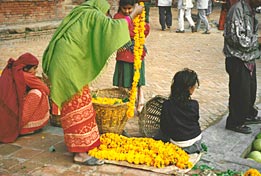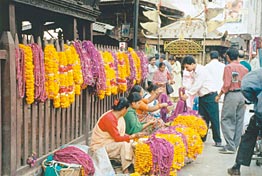
|
| Traditional wedding garlands |
Gnanam, a Hindu garland-maker
Author: Mary Ann Hamilton, Getting Married project
Getting Married: As maker of the beautiful garlands which are a central element in Hindu weddings, Gnanam Murthukrishnam plays an important part in making weddings in the Sydney Hindu community the festive and joyful events that they are.
The importance of a well-pleated sari!
During her 30 years living in Australia, Gnanam Murthukrishnam has helped many
families to prepare for the weddings of their children. The fresh flower garlands
that she makes are an essential part of the Hindu wedding ceremony, as is her
skill at pleating a wedding sari properly!
 |
 |
|
(Gnanam) Many people don’t know how put on a sari properly.
I learned all my tricks from a close friend who was an air hostess in India
in 1968. Dressing properly in the wedding sari is very important!
|
The trick is, as Gnanam advises, to accommodate the individual tummy when pleating!
Hindu marriage
In India, Hindu marriages are traditionally arranged between families, although
today this is often no longer the case. The rituals and events involved in a
wedding celebration vary throughout the different regions of India and between
the different castes. Gnanam related the events that traditionally take place
in a South Indian wedding of the Brahmin caste, the Indian priestly hereditary
caste.
Preparing for the wedding
The days leading up to the wedding are busy with various pre-wedding
ceremonies and visits, including a formal visit to the bride by the groom and
his family. This is the day on which the groom’s family gives the bride
her wedding sari and jewellery. The sari is always red which is an auspicious
colour in Indian culture. The jewellery set includes the Mangal sutra,
an elaborate gold necklace.
Turmeric days are held at the bride and the groom’s homes and offer the
opportunity for family and friends to celebrate the forthcoming wedding. Traditionally
only the girl would have a special day set aside where mehndi or henna
designs are painted on her hands and sometimes her feet by friends. This day
is full of cooking, eating, singing and dancing and is a really lively celebration
of the girl’s forthcoming marriage. These days it has become fashionable
for young men to have a mehndi celebration as well.
The wedding ceremony
The wedding begins with lengthy puja ceremonies. These are Hindu religious
ceremonies, where prayers for the groom and the bride and their marriage are
offered by the priest conducting the wedding. After this the couple sit together
under the wedding mandapam, a decorative canopy.
To the accompaniment of loud drumming, intended to mask bad words and intentions
of anyone who may oppose the marriage, the groom ties the Mangal sutra around
the girl’s neck. This necklace is like the ring in a western marriage
and indicates the permanence of the marriage union. It is knotted three times,
twice by the husband, once by the bride’s sister-in-law.
 |
 |
|
The boy’s sister plays a very important part in
the wedding ceremony. During the ceremony she carries a lamp with which she
symbolically welcomes the bride, and she also puts the third knot in the Mangal sutra… In the old days if anything went wrong in the marriage the
sister-in-law was responsible… The bride could not go back to her father’s
home after she was married….
|
The next important part of the ceremony happens when the couple walk three
times around a small fire lit by the priest. They sit and the girl places her
foot on a special stone so that the groom can fit a small ring onto her toe.
The couple exchange flower garlands. The fire is the witness to the marriage
and the stone represents the strong foundation on which the marriage is made.
When these ceremonies are completed the bride and groom are embraced by their
family members who tie half sovereign pieces around the bride’s head.
These are later tied to the Mangal sutra and kept.

Wedding garland sellers
Beginning married life
After the marriage ceremony the girl traditionally visits her father’s
home, and the groom his, while they await the appropriate time for the imminent
beginning of their life together. Astrology is used to determine a suitable
date for the couple to spend their first night together.
 |
 |
|
It must be an auspicious day, the conception of
the first child must be a very auspicious occasion. The first night has to occur
within a month of the wedding… This is all planned out in consultation
with the astrologer long before the wedding takes place.
|
On that first night the marriage bed is decorated with rose petals and jasmine.
A bed of roses that will hopefully last forever.
Indian weddings in Australia
Indian Hindu weddings in Australia have changed somewhat over the 30
years Gnanam has been here. These variations are mainly aimed at shortening
the very lengthy ceremonies, and accommodating the guests while the numerous
and intricate parts of the proceedings are undertaken by the bride and groom.
But since all of the observances described above form the core of the Hindu
marriage ceremony, they are retained and witnessed by the couple’s family
and friends in Hindu weddings in Australia.
Today, after three decades in Australia, Gnanam still treasures her role in
Australian Hindu wedding celebrations in Sydney.
>
Back to Synthi & Mohamed's wedding
> Take a look at some more weddings
|


